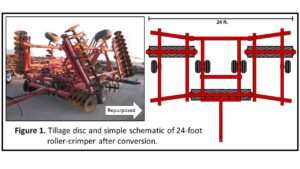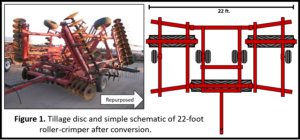Final report for ONC21-093
Project Information
The latest SARE cover crop survey reports a doubling of cover crop acres over the past 5 years, which has improved soil health on cropland acres. However, farmers regularly rely on disturbances like tillage or herbicides to terminate cover. Roller-crimping is a soil health conscience alternative termination method of popular cover crops, e.g., cereal rye. Insufficient availability of roller-crimpers in many NCR-SARE states coupled with the expense of new machines ($32,500 for a 20 ft crimper) are hurdles preventing the adoption of this soil health practice.
To address this problem, Ecdysis Foundation collaborated with farmers in eastern South Dakota to develop a do-it-yourself guide for repurposing a disc into a low-cost roller-crimper (Figure 1). The supply cost of this machine, $5,883, was 18% of a new brand-name crimper of similar size. Detailed plans accompany a series of how-to videos hosted on Ecdysis’ YouTube channel. Our shop-built crimper was field tested over two field seasons to determine it's durability and efficacy to terminate the region's most abundantly planted cover crop, cereal rye. The six local farmers that field tested our roller-crimper reported the machine design functioned proficiently and held-up well in the field. One design improvement noted during field testing was the need for an axle shield to prevent cover crops from wrapping around the roller drum axles between the drum and hanging bracket. This crimper design proved to be efficient at terminating a cereal rye cover crop, with a 90 - 95% kill rate when plants were at the appropriate stage for termination with crimping.
This project advances SARE’s mission of transforming agriculture along ecological principles by examining an innovative solution to reduce costs for farmers wanting to adopt roller-crimping, while also providing vital research on the potential for the tool to terminate popular cover crops.
- Work with local farmers to build a simple, affordable roller-crimper from a recycled disc and salvaged tillage equipment parts.
- Record the construction of a roller-crimper, and present the process as a freely available instructional guide and how-to video series.
- Establish research and demonstration plots at local farms to study the effectiveness of roller-crimping various cover crops.
- Conduct in-person and online outreach and education activities with Ecdysis and community partners, showcasing the roller-crimper for farmers interested in reduced-disturbance cover crop termination.
Cooperators
- - Technical Advisor (Educator and Researcher)
- (Educator and Researcher)
- (Researcher)
- (Researcher)
- (Researcher)
- (Researcher)
Research
This project entails two research projects 1) build an affordable roller-crimper from a recycled disc and salvaged tillage equipment parts (Figure 1) and 2) study the effectiveness of our constructed crimper to terminate various cover crops.
Objective 1: Build an affordable roller-crimper
Gather materials
- Disc: There are several types of tillage equipment that can be recycled into a roller-crimper, but we found small to mid-size discs to be both affordable and easy to source in the Upper Midwest. For this project, an International 490 disc (22 ft. wing span) was selected as the roller-crimper frame. The size of crimper can easily be scaled up or down by simply selecting a larger or smaller piece of used equipment to serve as the frame. Fortunately, there are many used equipment in the Upper Midwest available in a variety of sizes that can be recycled into a roller-crimper.
- Crimper drums: To prevent gaps in cover crop crimping, the crimping drums need to overlap slightly. International 490 22' discs have two 6' wings with a 10' center section. Therefore, we salvaged two 6'8" steel tubes for the wings and an 11' steel tube for the center to serve as the crimper drums. All tubes were 16" outside diameter. We sourced the steel tubes from a local metal recycling center, which charged scrap price for the metal. This saved a lot of money compared to buying new steel tubes.
- Crimper blades and gussets: Steel plates (4" width, 1/4" thickness) were used for crimper blades. Blades affixed to wing drums (n = 88 blades) were cut to 20.75" in length, and blades affixed to center drum (n = 66 blades) were cut to 22.833" in length. Gussets (n = 462) (1 1/2" x 3", 1/4" thickness) were affixed to the back of crimper blades for support (3 gussets per blade).
- Crimper drum caps: Steel plates (n = 7 drum caps, 1/2" thickness) were cut to the inside diameter of crimper drums with 1 3/4" hole cut into the center to receive bearing assembly for attachment of drum to disc frame.
- Crimper drum axles: Steel bars (1 3/4" diameter) served as the axles for the crimper drums. Axles ran the entire length of each drum to provide strength and stability to the axle mechanism. This required 12' and 8'4" (n=2) lengths of steel bars for the center and wing drums, respectively.
- Wing drum toolbars: Steel toolbars (7" x 7" square steel tubing, 8' length) (n=2) were used to hang crimper drums from the wing frames. These were sourced from an scraped piece of farm equipment (International 800 Cyclo Air Planter).
- Crimper drum mounting brackets: Brackets were manufactured from 1/2" thick steel. Brackets attached to crimpers drum axles with bearings to suspend the crimper drums under the disc frame.
Assembly steps
All stages of assembly were recorded, and are available to the public in a how-to video series on Ecdysis Foundation's YouTube page.
- Remove disc gangs from frame. Save gang assembly for parts or to be sold as scrap to offset some cost of build.
- Make any needed repairs to disc frame, remember to check tires and hydraulic lines.
- Prepare crimper drums for welding blades.
- Remove rust, paint, or any other foreign material from the drum surface, so it is only clean metal, ready to be welded.
- Mark rows for attachment of crimper blades. First, a chalk line is snapped onto drum surfaces running the length of the drum. Chalk lines (n = 22 rows/drum) are spaced 2.2848" apart to ensure crimper rows are all equidistant apart on 16" outside diameter drums.
- Mark attachment points of crimper blades along chalk lines. Crimper blades are arranged in a staggered fashion with 1" overlap between rows (Figure 2).
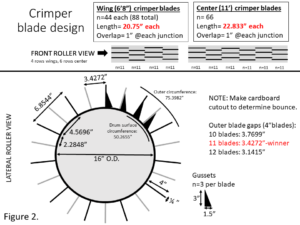
- Weld gussets to crimper blades. Three gussets were welded to back of crimper blade; one in the center and the other two gussets 1" from the blade edge.
- Weld blades in premarked slots on crimper drums.
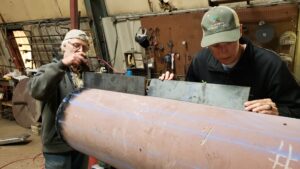
- Weld endcaps onto crimper drums.
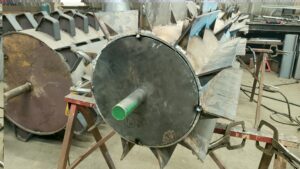
- Weld one of the endcaps to the center of the 12' axle of the center drum. This will support the middle of the axle. Cut three notches from the outside perimeter of this endcap before welding to the middle of the axle. The notches will allow water to flow from one side of the drum to the other when filling or draining.
- Test fit all endcaps in their respective drum ends before welding into place. Grind inside lip of crimper drums at 45° angle to help with fit and provide more surface area for weld. Then mount endcaps into the end of the drums with the axle running through the drum and endcap. The axle provides a convenient handle to center the endcap within the drum. Tack weld endcap in place and double check endcap is still centered. If centered, proceed to welding endcap in place.
- Weld axles to endcaps where axle contacts crimper drum endcaps. Be sure axle is centered relative to the length of the drum before welding into place. (See photo for finished crimper drum.)
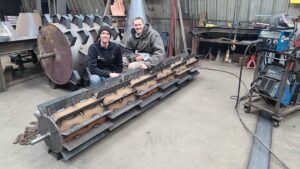
- Assemble brackets that will hang drums form the disc frame by welding the pieces together.
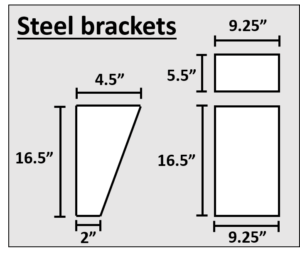
- Attach crimper drums to disc frame.
- Start with the center drum. Center the drum under the front of the disc frame in a position that prevents it from hitting the road tires. Next, slip brackets with bearing attached over drum axles and slide into position under the disc frame where bracket will be welded to the disc frame. When the drum and brackets are in the correct position, weld the brackets to the disc frame.
- The crimper drums on each wing require a piece of steel tubing (7" x 7" square tubing, 8' length) that serves as the toolbar to hang the crimper drums from the disc frame. Cut notches into steel tubing at intervals coinciding with the disc frame so that the steel tubing can attach as a yoke to the frame wings. When marking where to cut the notches from the steel tubing, be sure to position the tubing so the crimper drum on the wing will overlap the center drum sufficiently. Also, remember the wing drums need to be mounted far enough back on the wing to avoid contact with the disc tires when they fold back into field position.
- After the notches are cut from the steel tubing, weld the brackets to the ends of the tubing.
- Mount the steel tubing to the disc frame and tack weld it when in the correct position.
- Roll each crimper drum under the brackets and position the axles so that bearings can be slid over the axle and bolted to the brackets.
- Test to make sure wing drums do not contact disc tires when folding back into field position.
- Finish welding the steel tubing to the disc frame.
- The roller crimper is now assembled.
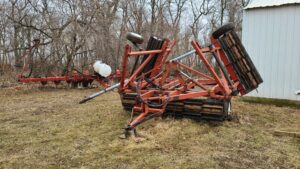
Objective 2: Test the ability of crimper to terminate a variety of cover crops
It was important to test the roller-crimper on participant farms to assess the durability and effectiveness of our design to terminate cover crops at scale. Therefore, the functionality of the constructed roller crimper to terminate a cereal rye cover crop was tested.
First, we tested the durability and functionality of our roller-crimper to withstand the rigors of crimping cover crops under field conditions. The crimper was used by six different farmers in seven fields during June of 2022 and 2023.
Second, we evaluated our roller-crimper's ability to terminate the most commonly planted cover crop in the region, cereal rye. To assess cover crop termination, a square meter quadrat (n = 25/field) was placed randomly within fields 5-10 days after being crimped. Within a quadrat sample, percentage killed cover crop was visually tallied.
Build an affordable roller-crimper
Construction of the roller crimper is completed, except for the addition of guards to prevent vegetation wrapping around the drum axle. The materials needed for the build were under $6,000 (Figure 3). The total hours spent gathering supplies and constructing the crimper were 190. 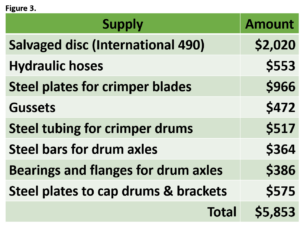
Test the ability of crimper to terminate a variety of cover crops
In June 2022, we tested the durability of our roller-crimper to withstand crimping a cover crop under field conditions. The first test was conducted in a field of volunteer cereal rye. The roller crimper rolled smoothly through the cover crop and the structural integrity of the crimper remained intact. This was a successful first test of our manufactured crimper. It rolled and crimped the cover crop adequately, although the volunteer stand of rye was thin, which hindered some of the crimping action. The crimper was then tested on a 6 acre field of cereal rye cover crop that was planted green to soybeans earlier that spring. The ability of the crimper to terminate the cover crop was better than the first test (likely because the stand of rye was thicker and uniform in growth stage). Additionally, the crimper did not harm the young soybean crop. The third and final test of the season was not performed on a cover crop, but a 30 acre patch of Canadian thistles. The crimper successfully terminated the thistles just before they entered the seed dispersal stage. Each test was performed by a different farmer, and all farmers reported the roller crimper terminated their cover crops (or thistle patch) to their satisfaction. We did learn that guards are needed to prevent wrapping of vegetation around the roller drum axle between the drum and the bracket. We also have inserted sealable bungholes into each drum so water can be added to add more weight to the roller crimper when needed.
In the 2023 field test season, cooperating farmers had a difficult time establishing cover crops in fields designated for testing the roller-crimper. Consequently, rye did not establish a thick, uniform stands that are ideal for terminating a cover crop by crimping. Furthermore, germination time of rye varied considerably within most of the fields causing difficulty when determining the appropriate time to test our crimper's ability to terminate rye, as it varied anywhere between the boot and the ripening stage in many fields. Together, these circumstances created poor conditions for assessing the ability of the crimper to terminate a rye cover crop. To overcome these hurtles, the farmer cooperators waited as long as feasible before crimping the cover crop to allow as much of the cover crop as possible to reach the flowering stage. Just like in the 2022 season, the farmers reported the crimper was easy to use and held-up well under field conditions. Measurement of cover crop termination by our roller crimper showed an average kill rate between 90% - 95% of the rye in the fields. We felt this was an excellent result, considering the adverse conditions we faced.
Educational & Outreach Activities
Participation Summary:
The home of Ecdysis Foundation (Blue Dasher Farm) hosted a field day in August 2022 and 2023. The roller crimper was featured during each of these field day events that an estimated 200 people attended. Drs. Mike Bredeson and Ryan Schmid together with a cooperating farmer from the build explained roller crimping, the build process, and answered questions from attendees. In November 2022, Dr. Schmid presented on the construction process of the roller crimper at the South Dakota Local Foods Conference and the National Cover Crop Summit. An estimated 200 people were in the audience. Dr. Schmid has also been contacted by two farmers in the Midwest that are planning to build their own crimpers. He consulted with them to troubleshoot their design ideas.
Learning Outcomes
Project Outcomes
This project provided farmers an affordable means to acquire an important sustainability tool, the roller-crimper, by either manufacturing it themselves or giving the provided plans and instructions to a local machine shop (the cost of which is included in this proposal; if farmers manufacture the crimper themselves it would be an additional cost savings). As a result of developing accessible roller-crimper plans, cooperating farmers began to consider crimping as a feasible alternative to tillage and herbicides for cover crop termination. In 2022 and 2023, 161 acres of cereal rye cover crops belonging to five farmer cooperators were terminated using the our manufactured roller-crimper. The number of acres will increase as we continue to rent out our roller-crimper to local farmers and as more farmers use plans and videos from this project to develop their own crimpers. We experienced 100% of the farmers that used our crimper expressed an increased interest in terminating cover crops by roller-crimper in the future, and 50% of these farmers showed an interest in using plans to build their own roller-crimper. Within 5 years of initiating this project, we expect to publish 15 popular press and 1-3 peer reviewed articles detailing research and farmer reactions to using roller-crimpers resulting from this proposal. The roller-crimper will allow Ecdysis to significantly bolster publicly available data on circumstances where crimping is a favorable technique.
Information Products
- Field Disc Converted To Roller/Crimper (Article/Newsletter/Blog)
- Video: DIY Low-Cost Roller-Crimper with Ryan Schmid (Multimedia)
- DIY roller-crimper plans and dimensions (Manual/Guide)
- Video: Building an Affordable Roller-Crimper with Ryan Schmid (Multimedia)
